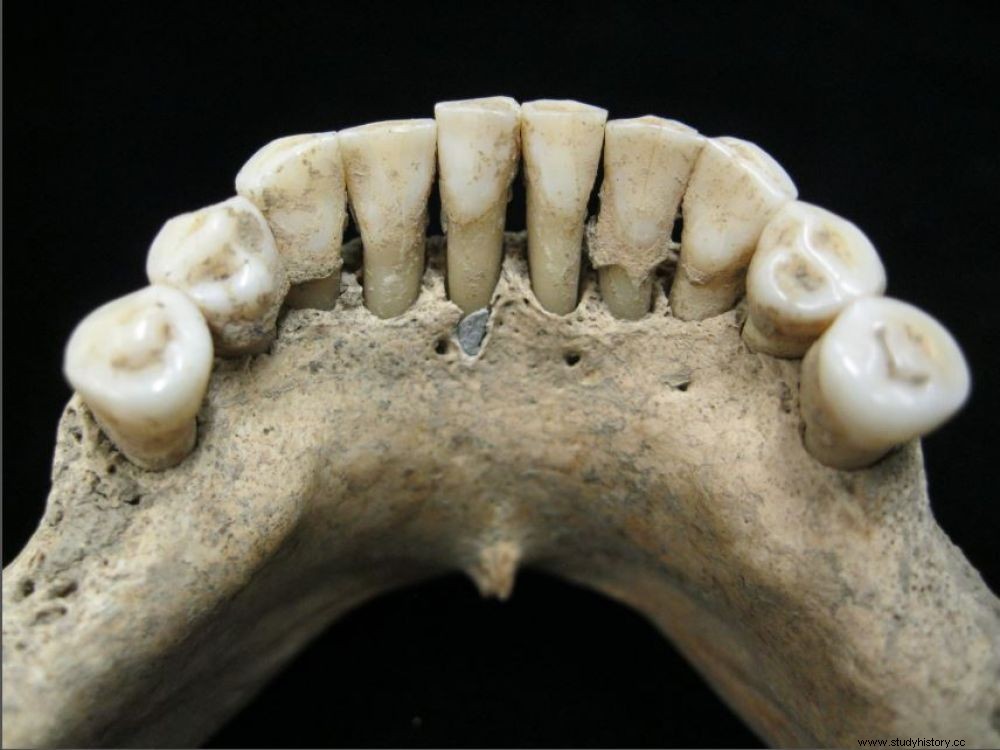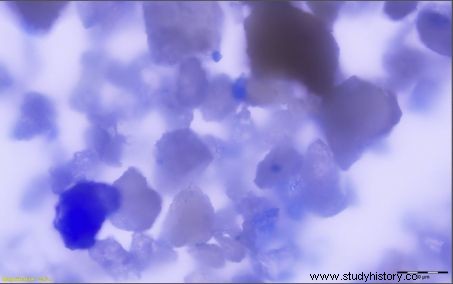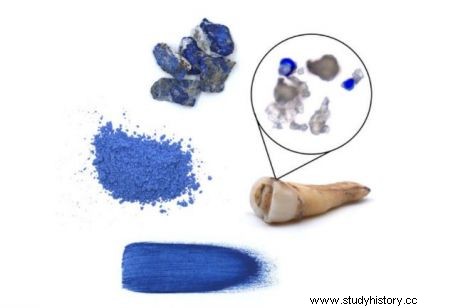Traces of lapis lazuli embedded in the dental plaque of a woman who lived in medieval times suggest that she may have been the first copyist and painter of illuminated manuscripts ever encountered. A discovery that calls into question the belief that only men fulfilled this role.

Lower jaw of a 12th century woman with lapis lazuli pigment chips preserved in dental calculus. Their presence indicates that this woman was working on precious illuminated manuscripts.
Tiny ultramarine particles found trapped in the dental stones (calcified tartar) of a nun who died in Germany between 997 and 1162, were found to be lapis lazuli remains. At the time, this ornamental stone came from the Hindu Kush mountains, in what is now Afghanistan, from where it was transported to the Levant by land, along the silk roads, before being marketed at high prices. gold in the West. In the twelfth century, this silicate of aluminum and sodium of great brilliance, ground into a fine powder, was used to paint the illuminations of the most luxurious and richly decorated manuscripts. These works were adorned with sumptuous paintings in which gold and silver pigments competed with the deep ultramarine blue drawn from lapis lazuli (read box ). But the interest of this discovery is above all to awaken a forgotten history. The role played by female scribes in certain religious communities in the Middle Ages.

Lapis lazuli particles detected in medieval dental stones. ©Monica Tromp
It is by carrying out crystallographic analyzes, by micro-Raman spectroscopy (non-destructive technique for characterizing the molecular composition) of these samples of dental calculus, as explained in an article published in the journal Science Advances> , that an international team, including in particular the Italian researcher Anita Radini, from the University of York (United Kingdom) as well as scientists from the Max Planck Institute for the History of Science (Germany), obtained these results. A woman aged between 45 and 60, exhumed from the cemetery of the monastery of Dalheim, near Lichtenau (Germany), showed traces of blue pigment embedded in her teeth.
Tiny ultramarine particles found trapped in the dental stones (calcified tartar) of a nun who died in Germany between 997 and 1162, were found to be lapis lazuli remains. At the time, this ornamental stone came from the Hindu Kush mountains, in what is now Afghanistan, from where it was transported to the Levant by land, along the silk roads, before being marketed at high prices. gold in the West. In the XII th century, this highly lustrous aluminum and sodium silicate, ground into a fine powder, was used to paint the illuminations of the most luxurious and richly decorated manuscripts. These works were adorned with sumptuous paintings in which gold and silver pigments competed with the deep ultramarine blue drawn from lapis lazuli (read box ). But the interest of this discovery is above all to awaken a forgotten history. The role played by female scribes in certain religious communities in the Middle Ages.

Lapis lazuli particles detected in medieval dental stones. ©Monica Tromp
It is by carrying out crystallographic analyzes, by micro-Raman spectroscopy (non-destructive technique for characterizing the molecular composition) of these samples of dental calculus, as explained in an article published in the journal Science Advances> , that an international team, including in particular the Italian researcher Anita Radini, from the University of York (United Kingdom) as well as scientists from the Max Planck Institute for the History of Science (Germany), obtained these results. A woman aged between 45 and 60, exhumed from the cemetery of the monastery of Dalheim, near Lichtenau (Germany), showed traces of blue pigment embedded in her teeth.

Lapis lazuli pigment, crushed and powdered, for use by illuminating artists. ©Christina Warinner / Monica Tromp
"We looked at many scenarios of how this mineral could have been incorporated into this woman's dental plaque “said Anita Radini, co-signer of the publication, in a press release from the Max Planck Institute. After studying the distribution of the pigment in the mouth, the researchers speculated that while painting, she sucked on the end of her brush to replenish the fine point. The unexpected discovery of such a precious pigment in the mouth of an 11th century woman century is indeed unprecedented, the statement added. Medieval artists did not sign their works. One certainty, Germany at that time was an active center of manuscript making. The low visibility of women's work in these productions has led many researchers to assume that they had little participation in them. A conjecture now called into question by this study.

Guda, 12th th century, would have been one of the first copyist nuns in Europe. © Public Domain
Moreover, we already knew the name of a certain Guda, German illuminator active in the twelfth century. century, which is depicted on a drop cap with the following inscription:"Guda, peccatrix mulier, scripsit et pinxit hunc librum (Guda, a sinner, wrote and illuminated this book). Obviously, Guda wasn't alone!
A brief history of blue
This color so popular today was not always in vogue. The Romans, for example, did not like it. It was for them characteristic of the Barbarians (Celts or Picts covered their bodies with it to go into battle). Historian Michel Pastoureau, a specialist in the symbolism of colors, says that it was through the Germans that the fashion for blue fabrics entered the West from the III
th
century. The promotion of blue would then have taken place in 3 stages:in the XII
th
century, all that was divine turned blue. The Sky (hitherto silver, gold, white); the Virgin, dressed in blue from this date, until the sovereigns who would follow in her footsteps at the dawn of the 13
th
century, making blue a royal color. In the XVI
th
century, when it is no longer fashionable to dress in shimmering hues, -farewell to the elegant ones in yellow, red and green breeches-, blue joins the black and gray in which most people wore, to be the most worn color nowadays in the West (jeans obligatory). As for the 3
th
period, it dates back to the 18
th
century. Technical changes among painters and the arrival of new dyes have contributed to diversifying the palette of this color, making this century a great century of blues. Prussian blue, a new pigment will thus be invented in Berlin. And from the Americas will be brought back a powerful dye plant (again according to the words of Michel Pastoureau):American indigo. Remember, however, that the ancient Egyptians had already created a synthetic blue called Egyptian blue, more than 4000 years ago.
